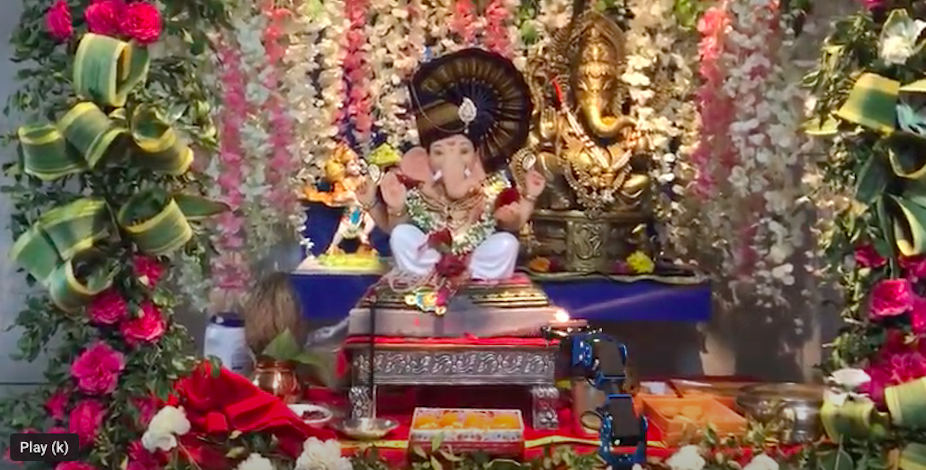It isn’t just artists and teachers who are losing sleep over advances in automation and artificial intelligence. Robots are being brought into Hinduism’s holiest rituals – and not all worshippers are happy about it.
In 2017, a technology firm in India introduced a robotic arm to perform “aarti,” a ritual in which a devotee offers an oil lamp to the deity to symbolize the removal of darkness. This particular robot was unveiled at the Ganpati festival, a yearly gathering of millions of people in which an icon of Ganesha, the elephant-headed god, is taken out in a procession and immersed in the Mula-Mutha river in Pune in central India.
Ever since, that robotic aarti arm has inspired several prototypes, a few of which continue to regularly perform the ritual across India today, along with a variety of other religious robots throughout East Asia and South Asia. Robotic rituals even now include an animatronic temple elephant in Kerala on India’s southern coast.
Yet this kind of religious robotic usage has led to increasing debates about the use of AI and robotic technology in devotion and worship. Some devotees and priests feel that this represents a new horizon in human innovation that will lead to the betterment of society, while others worry that using robots to replace practitioners is a bad omen for the future.
As an anthropologist who specializes in religion, however, I focus less on the theology of robotics and more on what people actually say and do when it comes to their spiritual practices. My current work on religious robots primarily centers on the notion of “divine object-persons,” where otherwise inanimate things are viewed as having a living, conscious essence.
My work also looks at the uneasiness Hindus and Buddhists express about ritual-performing automatons replacing people and whether those automatons actually might make better devotees.
Ritual automation is not new
Ritual automation, or at least the idea of robotic spiritual practice, isn’t new in South Asian religions.
Historically, this has included anything from special pots that drip water continuously for bathing rituals that Hindus routinely perform for their deity icons, called abhisheka, to wind-powered Buddhist prayer wheels – the kinds often seen in yoga studios and supply stores.
While the contemporary version of automated ritual might look like downloading a phone app that chants mantras without the need for any prayer object at all, such as a mala or rosary, these new versions of ritual-performing robots have prompted complicated conversations.
Thaneswar Sarmah, a Sanskrit scholar and literary critic, argues that the first Hindu robot appeared in the stories of King Manu, the first king of the human race in Hindu belief. Manu’s mother, Saranyu – herself the daughter of a great architect – built an animate statue to perfectly perform all of her household chores and ritual obligations.

Folklorist Adrienne Mayor remarks similarly that religious stories about mechanized icons from Hindu epics, such as the mechanical war chariots of the Hindu engineer god Visvakarman, are often viewed as the progenitors of religious robots today.
Furthermore, these stories are sometimes interpreted by modern-day nationalists as evidence that ancient India has previously invented everything from spacecraft to missiles.
Modern traditions or traditionally modern?
However, the recent use of AI and robotics in religious practice is leading to concerns among Hindus and Buddhists about the kind of future to which automation could lead. In some instances, the debate among Hindus is about whether automated religion promises the arrival of humanity into a bright, new, technological future or if it is simply evidence of the coming apocalypse.
In other cases, there are concerns that the proliferation of robots might lead to greater numbers of people leaving religious practice as temples begin to rely more on automation than on practitioners to care for their deities. Some of these concerns stem from the fact that many religions, both in South Asia and globally, have seen significant decreases in the number of young people willing to dedicate their lives to spiritual education and practice over the past few decades. Furthermore, with many families living in a diaspora scattered across the world, priests or “pandits” are often serving smaller and smaller communities.
But if the answer to the problem of fewer ritual specialists is more robots, people still question whether ritual automation will benefit them. They also question the concurrent use of robotic deities to embody and personify the divine, since these icons are programmed by people and therefore reflect the religious views of their engineers.
Doing right by religion
Scholars often note that these concerns all tend to reflect one pervasive theme – an underlying anxiety that, somehow, the robots are better at worshipping gods than humans are. They can also raise inner conflicts about the meaning of life and one’s place in the universe.
For Hindus and Buddhists, the rise of ritual automation is especially concerning because their traditions emphasize what religion scholars refer to as orthopraxy, where greater importance is placed on correct ethical and liturgical behavior than on specific beliefs in religious doctrines. In other words, perfecting what you do in terms of your religious practice is viewed as more necessary to spiritual advancement than whatever it is you personally believe.
This also means that automated rituals appear on a spectrum that progresses from human ritual fallibility to robotic ritual perfection. In short, the robot can do your religion better than you can because robots, unlike people, are spiritually incorruptible.
This not only makes robots attractive replacements for dwindling priesthoods but also explains their increasing use in everyday contexts: People use them because no one worries about the robot getting it wrong, and they are often better than nothing when the options for ritual performance are limited.
Saved by a robot
In the end, turning to a robot for religious restoration in modern Hinduism or Buddhism might seem futuristic, but it belongs very much to the present moment. It tells us that Hinduism, Buddhism and other religions in South Asia are increasingly being imagined as post- or transhuman: deploying technological ingenuity to transcend human weaknesses because robots don’t get tired, forget what they’re supposed to say, fall asleep or leave.
More specifically, this means that robotic automation is being used to perfect ritual practices in East Asia and South Asia – especially in India and Japan – beyond what would be possible for a human devotee, by linking impossibly consistent and flawless ritual accomplishment with an idea of better religion.
Modern robotics might then feel like a particular kind of cultural paradox, where the best kind of religion is the one that eventually involves no humans at all. But in this circularity of humans creating robots, robots becoming gods, and gods becoming human, we’ve only managed to, once again, re-imagine ourselves.

